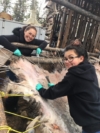Riding Out the Storm
How the worst climbing conditions can bring out the best in us.
All photos by Drew Smith
The scene reflected in Drew’s camera lens confirms how ridiculous our situation is: Siebe’s shivering at the hanging belay. He’s been waiting to belay me for over an hour. I can see Sean, too. Like me, he’s trying to dig ice out of a frozen crack. Instead of climbing, I’m hammering at ice with a nut tool. We’ve been on the wall for 11 days now and have been waiting out the weather for the past seven. We’re in Patagonia on pitch 23 of Riders on the Storm, with hard climbing still ahead of us. I’m starting to wonder if our only chance at freeing the route depends on how much we’re willing to suffer. At this point, I’m hitting the ice more to stay warm than to clean the pitch. What am I doing here?
I’ve been climbing for a couple of decades, but this is the first time I have even considered climbing in these conditions. Temps are below freezing. The wind is howling. The rock is filled with ice. I can barely feel my fingers in my gloves, and I can’t feel my feet at all. At the same time, the prospect of being stuck in our portaledge for another two days during the incoming storm has persuaded me that we have nothing to lose by trying.
One by one, I go over each move and piece of protection of the attempt in my head, addressing every risk involved. I try to fuel myself with positivity, but the weather, the exposure and my teammates’ silence make all my doubts seem louder and louder.

“After all these years coming back to Torres del Paine, I still get the same feeling when I see these towers,” Nico says. “What a place!”

Nico, Sean and Siebe Vanhee (not shown) make their way to the route. “The closer I get to the towers, the smaller I feel,” Nico says.
I remember so well being right here almost 20 years ago. Back then, I had absolutely no idea that the experience would shape the following 18 years of my climbing. I was in my early 20s, diving into my first time climbing an alpine big wall. I was like a kid in a candy store, hungry for adventure but with so little experience. Now, I am a married man in my 40s. My climbing has improved in many ways, but I have also witnessed the heavy consequences of misjudgments or random mountain hazards on this kind of terrain.
I am not so sure if back then I was less aware of it or if I was just less scared of getting hurt, but being back here after all this time makes me realize that I think a lot more about the consequences than I used to. I accept backing off things more easily than I have in the past. Thanks to the powerful experiences I have earned while climbing big walls all over the world, I have gained a life I love, a life I think I am scared of losing more than before.
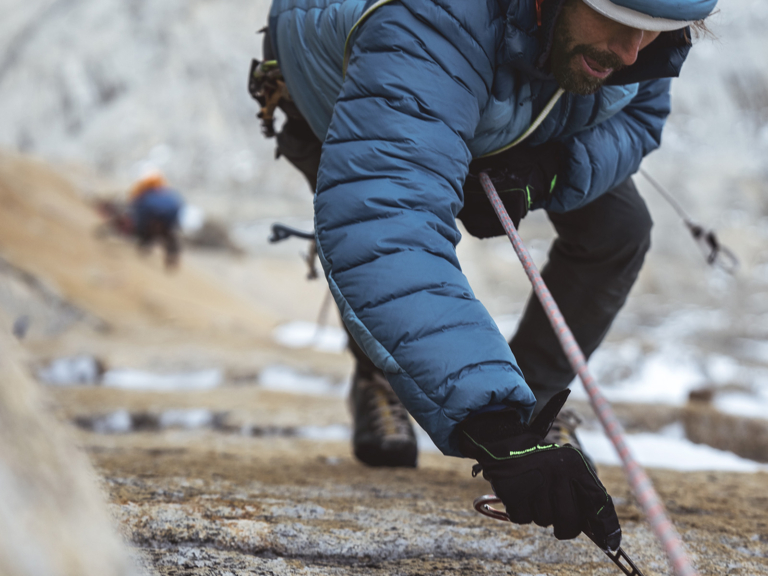
As I scrape off snow and ice from the holds of pitch 23, I wonder, “What am I doing here?” I had never before considered free climbing at such a hard level in such cold conditions.
Now we’re back on Riders on the Storm and trying to put up the first free ascent. I remember this pitch, in particular, being very tricky, climbing through very thin cracks to overcome a perfect golden shield of granite at the steepest part of the wall. It is the key to unlocking the upper part of the route and barely goes free. Each hold is crucial, climbing through clean features with the exposure of 800 meters (about 2,600 feet) of air above a magnificent Patagonia landscape. It’s my definition of a perfect pitch. At least when I’m not scraping ice from it.
I feel the pressure weighing heavily on my shoulders knowing that today’s slim chance of progress depends on me. Sean’s stoic attitude makes it hard for me to read his emotions. Is he still really believing it’s going to go today? I imagine pulling hard moves, barehanded, in this icy crack. As a spindrift refills all the holds I have just cleaned, I can’t ignore the hopelessness of the situation anymore. “It’s extreme,” is what I manage to say.
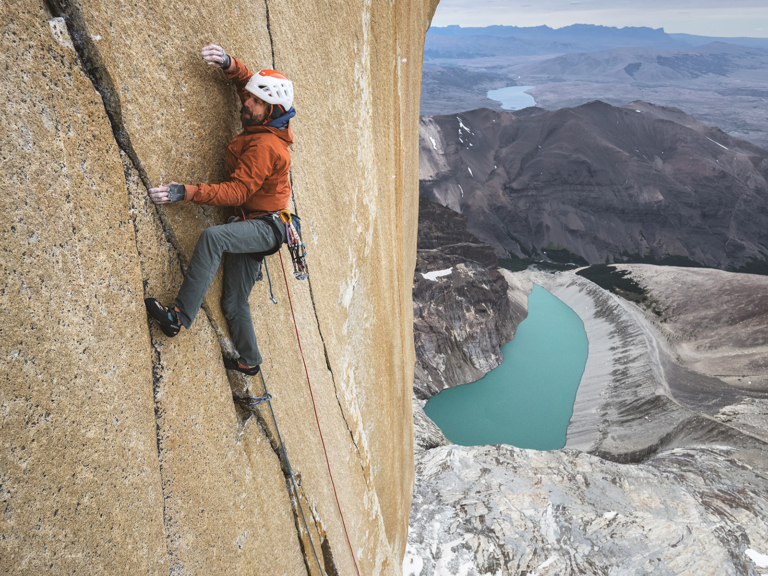
Pitch 23 is my definition of a perfect pitch, where it seems like each hold is just there to make a magical pathway to the upper part of the wall.
Sean turns to me and simply replies, “We are here now. We must try it. Make it in good condition.” Then he keeps cleaning.
He was right. There was no point in questioning what we were doing. By sharing my doubts, maybe I had wanted a bit of compassion, but Sean knew that in this moment empathy could easily slip into overthinking. We needed to stay mentally strong. I just needed to shut off my brain and keep scraping out the ice so that when the time to climb comes, if it ever comes, we would be ready. We had no reason to believe that it would get warmer or that the wind would die down. But we were still better off up here than stuck in our portaledge for another day.
Over the years, I have wondered where my motivation to get out of my comfort zone comes from. If I was alone, I would have given up for sure. But with everyone here, I can dig deeper because we all share the same dream.

Sean gets caught by weather on pitch 4 of Riders on the Storm.
Two hours later, the pitch is finally clean enough for an attempt. I warm up by practicing the moves one last time on top rope, forcing my fingers to get as numb as possible. It’s the best way I’ve found to get the most out of my fingers in extremely cold conditions. The pain is so great when the blood rushes back into my fingers that it makes me want to puke. Soon after the pain goes away my fingers can resist numbing out for a bit longer. While I repeat the crux sequence several times, I start noticing the holds getting slightly damp and the wind calming down, giving me that bit of hope I needed.
I lower down quickly to the anchor where Siebe is waiting. Everybody gets in position as I rack up, already rehearsing each move of the route in my head. As I unleash from the anchor, my heartbeat vibrates through my body. I am so excited that I feel shaky on the first few moves, but as I get farther, I fine-tune my pace and get in the flow.

Reorganizing the ropes at the belay before bailing. It’s important to make sure everything is ready for the incoming storm so our gear stays in good shape.
The rock is freezing but I climb quickly, executing each move as practiced. My fingertips start to numb out as I enter the crux sequence. All of a sudden, my 30 years of climbing experience seems to come together, just in time for me to face this challenge, which right now seems to be the hardest thing I have ever faced. I feel the energy of Siebe, Sean and Drew climbing with me. As I lose feeling in my fingers, with each move I try to compensate by squeezing more power from my body. The key hold on the last hard move has filled back in with snow, but I dig my fingers in and give everything. It feels like a miracle that I am still hanging on with my fingertips unable to feel anything. From there, an easier corner leads me to the top of the pitch. Relief surges through my body as I clip the anchor. There’s still 18 pitches to go, but I high-five Sean and Drew at the belay while Siebe screams from below to congratulate me. It was my lead, but they all seemed as happy as if it was theirs; because in a certain way, it was, and it made the whole experience even more rewarding.
Nico Favresse, Sean Villanueva O’Driscoll and Siebe Vanhee put up the first free ascent of Riders on the Storm over 18 days from January 24 to February 10, 2024. This photo essay captures key moments from the send.

It’s 11 p.m. and I’m finally back at camp as the storm rolls in. It’s been a long day of slow upward progress, and I can smell dinner inside the portaledge. I can’t wait to get inside, but first I need to get rid of the gear on my harness.

Sean on his morning commute.

Everything was frozen and cold, but we knew the weather would get worse in the next few days. We decided we might as well try to make progress.
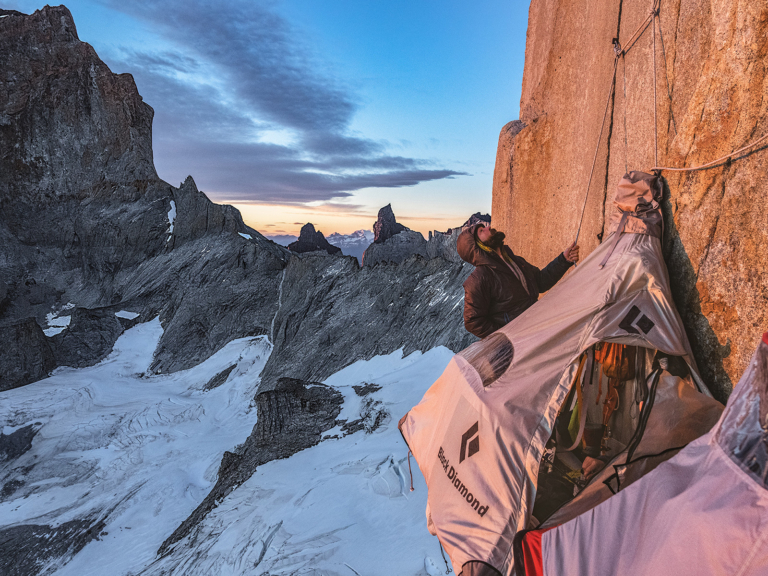
A rare but magical morning when the sun came out. Sean prepares for the next challenge.

When the weather is raging outside, there is no place to go but within yourself.
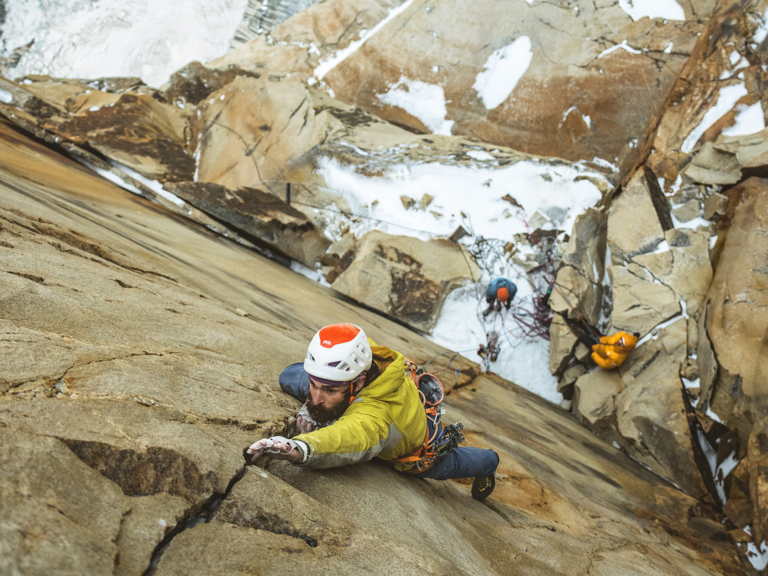
Sean on the last crux pitch of Riders on the Storm, a beautiful overhanging finger crack on pitch 30. The only challenge is that it’s way up there, and it’s very hard to get good climbing conditions. It can’t be too cold or else you can’t climb, but it also can’t be too warm, otherwise the crack turns into a waterfall.
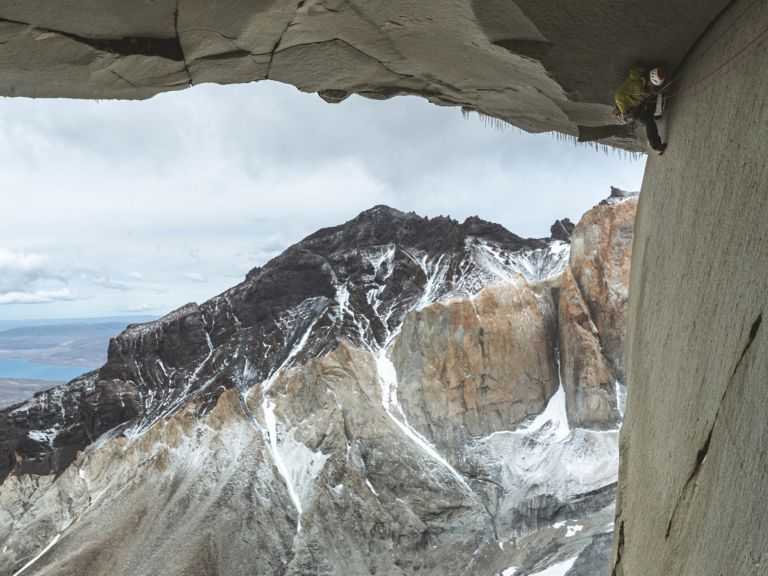
We knew it would be too cold, but Sean wanted to try. It must have been at least -5 degrees Celsius (23 degrees Fahrenheit), and we were already trying to stay warm at the belay. Only a few meters after Sean started, we heard him scream, fighting against his hands and feet becoming completely numb. His screams got louder and louder as if he was fighting for his life. He fell after just a few meters. Only then could he agree about the conditions being too cold.

Sean bloodied and a bit disappointed after a hard fight to onsite the steep 7c finger crack on pitch 31. Sean had broken his elbow only six weeks prior and still felt he hadn’t quite gotten his endurance back.

Artifacts from the first ascensionists. Riders on the Storm was first climbed in 1991 by Kurt Albert, Bernd Arnold, Norbert Bätz, Peter Dittrich and Wolfgang Güllich, and was originally graded VI 5.12d A3.

Life is simple on the wall. It consists of sleeping, climbing, eating, going to the toilet, reading and playing music. What else do you need?

Rappelling down from the summit. Since Riders is on the east face of the towers, this was one of the rare times we could see their shadows. Weather always comes from the west, so seeing the shadow meant good weather was coming.











